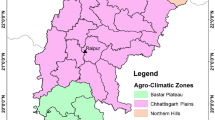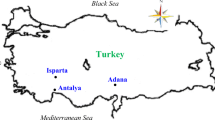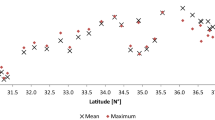Abstract
Accurate estimation of the reference evapotranspiration (ET0) is important for the water resource planning and scheduling of irrigation systems. For this purpose, the radial basis function network with particle swarm optimization (RBFN-PSO) and radial basis function network with back propagation (RBFN-BP) were used in this investigation. The FAO-56 Penman–Monteith equation was used as reference equation to estimate ET0 for Serbia during the period of 1980–2010. The obtained simulation results confirmed the proposed models and were analyzed using the root mean-square error (RMSE), the mean absolute error (MAE), and the coefficient of determination (R 2). The analysis showed that the RBFN-PSO had better statistical characteristics than RBFN-BP and can be helpful for the ET0 estimation.





Similar content being viewed by others
References
Allen RG, Pereira LS, Raes D, Smith M (1998) Crop evapotranspiration. Guidelines for computing crop water requirements, FAO irrigation and drainage paper 56, Roma, Italy
Allen RG, Pruitt WO, Wright JL, Howell TA, Ventura F, Snyder R, Itenfisu D, Steduto P, Berengena J, Beselga J, Smith M, Pereira LS, Raes D, Perrier A, Alves I, Walter I, Elliott R (2006) A recommendation on standardized surface resistance for hourly calculation of reference ET0 by the FAO56 Penman–Monteith method. Agric Water Manag 81:1–22
Alp M, Cigizoglu HK (2007) Suspended sediment load simulation by two artificial neural network methods using hydro meteorological data. Environ Model Softw 22(1):2–13
Aytek A (2009) Co-active neurofuzzy inference system for evapotranspiration modeling. Soft Comput 13:691–700
Broomhead DS, Lowe D (1988) Multivariate functional interpolation and adaptive networks. Complex Syst 2:321–355
Cai J, Liu Y, Lei T, Pereira LS (2007) Estimating reference evapotranspiration with the FAO Penman–Monteith equation using daily weather forecast messages. Agric For Meteorol 145:22–35
Cavuslu MA, Karakuzu C, Karakaya F (2012) Neural identification of dynamic systems on FPGA with improved PSO learning. Appl Soft Comput 12:2707–2718
Chandok JS, Kar IN, Tuli S (2008) Estimation of furnace exit gas temperature (FEGT) using optimized radial basis and back-propagation neural networks. Energy Convers Manag 49:1989–1998
Chen CS, Chen BPT, Chou FNF, Yang CC (2010) Development and application of a decision group Back-Propagation Neural Network for flood forecasting. J Hydrol 385(1-4):173–182
Cigizoglu HK (2005) Application of generalized regression neural networks to intermittent flow forecasting and estimation. J Hydrol Eng 10:336–341
Cobaner M (2011) Evapotranspiration estimation by two different neuro-fuzzy inference systems. J Hydrol 398(3–4):292–302
Cruz-Blanco M, Lorite IJ, Santos C (2014) An innovative remote sensing based reference evapotranspiration method to support irrigation water management under semi-arid conditions. Agric Water Manag 131(1):135–145
Fernández-Navarro F, Hervás-Martínez C, Gutiérrez PA, Carbonero-Ruz M (2011) Evolutionary q-Gaussian radial basis function neural networks for multiclassification. Neural Netw 24(7):779–784
Florido JP, Pomares H, Rojas I, Urquiza JM, Lopez-Gordo MA (2012) A deterministic model selection scheme for incremental rbfnn construction in time series forecasting. Neural Comput & Applic 21:595–610
Gaing ZL (2004) A particle swarm optimization approach for optimum design of PID controller in AVR system. IEEE Trans Energy Convers 19(2):384–391
Ghose DK, Panda SS, Swain PC (2010) Prediction of water table depth in western region, Orissa using BPNN and RBFN neural networks. J Hydrol 394(3-4):296–304
Gocic M, Trajkovic S (2010) Software for estimating reference evapotranspiration using limited weather data. Comput Electron Agric 71(2):158–162
Gocic M, Trajkovic S (2013) Analysis of changes in meteorological variables using Mann–Kendall and Sen’s slope estimator statistical tests in Serbia. Glob Planet Chang 100(1):172–182
Gocic M, Trajkovic S (2014) Analysis of trends in reference evapotranspiration data in a humid climate. Hydrol Sci J 59(1):165–180
Gocic M, Motamedi S, Shamshirband S, Petkovic D, Ch S, Hashim R, Arif M (2015) Soft computing approaches for forecasting reference evapotranspiration. Comput Electron Agric 113:164–173
Harpham C, Dawson CW (2006) The effect of different basis functions on a radial basis function network for time series prediction: a comparative study. Neurocomputing 69(16-18):2161–2170
Hasani M, Emami F (2008) Evaluation of feed-forward back propagation and radial basis function neural networks in simultaneous kinetic spectrophotometric determination of nitroaniline isomers. Talanta 75:116–126
Huan H, Hien D, Tue H (2011) Efficient algorithm for training interpolation RBF networks with equally spaced nodes. IEEE Trans Neural Netw 22(6):982–988
Huo Z, Feng S, Kang S, Dai X (2012) Artificial neural network models for reference evapotranspiration in an arid area of northwest China. J Arid Environ 82:81–92
Javan DS, Mashhadi HR, Rouhani M (2013) A fast static security assessment method based on radial basis function neural networks using enhanced clustering. Int J Electr Power Energy Syst 44(1):988–996
Jenifer S, Parasuraman S, Kadirvel A (2014) An efficient biomedical imaging technique for automatic detection of abnormalities in digital mammograms. J Med Imaging Health Inform 4(2):291–296
Juang C-F, Lo C (2008) Zero-order TSK-type fuzzy system learning using a two-phase swarm intelligence algorithm. Fuzzy Sets Syst 159:2910–2926
Kagoda PA, Ndiritu J, Ntuli C, Mwaka B (2010) Application of radial basis function neural networks to short-term streamflow forecasting. Phys Chem Earth A/B/C 35(13-14):571–581
Karimaldini F, Shui LT, Mohamed TA, Abdollahi M, Khalili N (2012) Daily evapotranspiration modeling from limited weather data by using neuro-fuzzy computing technique. J Irrig Drain Eng 138(1):21–34
Kennedy J, Eberhart R (1995) Particle swarm optimization. In: Proceedings of the sixth international symposium on micro machine and human science, Nagoya, Japan, pp. 39-43
Khoob AR (2008) Artificial neural network estimation of reference evapotranspiration from pan evaporation in a semi-arid environment. Irrig Sci 27(1):35–39
Kim S, Kim HS (2008) Neural networks and genetic algorithm approach for nonlinear evaporation and evapotranspiration modeling. J Hydrol 351:299–317
Kisi O (2006) Generalized regression neural networks for evapotranspiration modeling. Hydrol Sci J 51(6):1092–1105
Kisi O (2011a) Modeling reference evapotranspiration using evolutionary neural networks. J Irrig Drain Eng 137:636–643
Kisi O (2011b) Evapotranspiration modelling using a wavelet regression model. Irrig Sci 29(3):241–252
Kisi O (2013) Least squares support vector machine for modeling daily reference evapotranspiration. Irrig Sci 31(4):611–619
Kisi O, Cimen M (2009) Evapotranspiration modeling using support vector machine. Hydrol Sci J 54(5):918–928
Kisi O, Ozturk O (2007) Adaptive neurofuzzy computing technique for evapotranspiration estimation. J Irrig Drain Eng 133(4):368–379
Kumar M, Yadav N (2011) Multilayer perceptrons and radial basis function neural network methods for the solution of differential equations: a survey. Comput Math Appl 62(10):3796–3811
Kumar M, Raghuwanshi NS, Singh R, Wallender WW, Pruitt WO (2002) Estimating evapotranspiration using artificial neural network. J Irrig Drain Eng 128(4):224–233
Kumar M, Raghuwanshi NS, Singh R (2011) Artificial neural networks approach in evapotranspiration modeling: a review. Irrig Sci 29:11–25
Ladlani I, Houichi L, Djemili L, Heddam S, Belouz K (2012) Modeling daily reference evapotranspiration (ET0) in the north of Algeria using generalized regression neural networks (GRNN) and radial basis function neural networks (RBFNN): a comparative study. Meteorog Atmos Phys 118(3-4):163–178
Landeras G, Ortiz-Barredo A, Lopez JJ (2008) Comparison of artificial neural network models and empirical and semiempirical equations for daily reference evapotranspiration estimation in the Basque Country (Northern Spain). Agric Water Manag 95(5):553–565
Lin C, Wang J, Chen C, Chen C, Yen C (2009) Improving the generalization performance of RBF neural networks using a linear regression technique. Expert Syst Appl 36(10):12049–12053
Marofi S, Tabari H, Zare Abyaneh H (2011) Predicting spatial distribution of snow water equivalent using multivariate non-linear regression and computational intelligence methods. Water Resour Manag 25:1417–1435
Mateo J, Rieta JJ (2013) Radial basis function neural networks applied to efficient QRST cancellation in atrial fibrillation. Comput Biol Med 43(2):154–163
Mehrsai A, Karimi HR, Thoben KD, Scholz-Reiter B (2013) Application of learning pallets for real-time scheduling by the use of radial basis function network. Neurocomputing 101:82–93
Moody J, Darken CJ (1989) Fast learning in networks of locally-tuned processing units. Neural Comput 1(2):281–294
Motamedi S, Shamshirband S, Petković D, Hashim R (2015a) Application of adaptive neuro-fuzzy technique to predict the unconfined compressive strength of PFA-sand-cement mixture. Powder Technol 278:278–285
Motamedi S, Roy C, Shamshirband S, Hashim R, Petković D, Song K-I (2015b) Prediction of ultrasonic pulse velocity for enhanced peat bricks using adaptive neuro-fuzzy methodology. Ultrasonics (April). doi:10.1016/j.ultras.2015.04.002
Oh SK, Kim WD, Pedrycz W, Park BJ (2011) Polynomial-based radial basis function neural networks (P-RBF NNs) realized with the aid of particle swarm optimization. Fuzzy Sets Syst 163(1):54–77
Panda SS, Chakraborty D, Pal SK (2008) Flank wear prediction in drilling using backpropagation neural network and radial basis function network. Appl Soft Comput 8(2):858–871
Pereira LS, Allen RG, Smith M, Raes D (2015) Crop evapotranspiration estimation with FAO56: past and future. Agric Water Manag 147:4–20
Pérez-Godoy MD, Rivera AJ, Carmona CJ, del Jesus MJ (2014) Training algorithms for radial basis function networks to tackle learning processes with imbalanced data-sets. Appl Soft Comput 25:26–39
Petković D, Gocic M, Trajkovic S, Shamshirband S, Motamedi S, Hashim R, Bonakdari H (2015) Determination of the most influential weather parameters on reference evapotranspiration by adaptive neuro-fuzzy methodology. Comput Electron Agric 114:277–284
Qasem SN, Shamsuddin SM, Hassanien AE (2009) Hybrid learning enhancement of RBF network with particle swarm optimization. foundation of computational intelligence: studies in computational intelligence, vol 201. Springer, Berlin, pp 381–397
Qasem SN, Shamsuddin SM, Hashim SZM, Darus M, Al-Shammari E (2013) Memetic multiobjective particle swarm optimization-based radial basis function network for classification problems. Inf Sci 239(1):165–190
Rojas I, Valenzuela O, Prieto A (1997) Statistical analysis of the main parameters in the definition of radial basis function networks. LNCS 1240:882–891
Sedki A, Ouazar D, El Mazoudi E (2009) Evolving neural network using real coded genetic algorithm for daily rainfall-runoff forecasting. Expert Syst Appl 36(3):4523–4527
Shamshirband S, Petković D, Hashim R, Motamedi S (2014a) Adaptive neuro-fuzzy methodology for noise assessment of wind turbine. PLoS ONE 9(7):e103414
Shamshirband S, Petković D, Hashim R, Motamedi S, Anuar NB (2014b) An appraisal of wind turbine wake models by adaptive neuro-fuzzy methodology. Int J Electr Power Energy Syst 63:618–624
Shi Y, Eberhart R (1998) A modified particle swarm optimizer. In: The 1998 I.E. Internationalconference on evolutionary computation proceedings, Anchorage, AK,pp. 69-73
Shiri J, Nazemi AH, Sadraddini AA, Landeras G, Kisi O, Fard AF, Marti P (2014) Comparison of heuristic and empirical approaches for estimating reference evapotranspiration from limited inputs in Iran. Comput Electron Agric 108:230–241
Stockle CO, Kjelgaard J, Bellocchi G (2004) Evaluation of estimated weather data for calculating Penman–Monteith reference evapotranspiration. Irrig Sci 23:39–46
Su S, Chuang C, Tao C, Jeng J, Hsiao C (2012) Radial basis function networks with linear interval regression weights for symbolic interval data. IEEE Trans Syst Man Cybern B Cybern 42(1):69–80
Tabari H, Hosseinzadeh Talaee P (2013) Multilayer perceptron for reference evapotranspiration estimation in a semiarid region. Neural Comput & Applic 23(2):341–348
Tabari H, Marofi S, Sabziparvar AA (2010) Estimation of daily pan evaporation using artificial neural network and multivariate non-linear regression. Irrig Sci 28:399–406
Tabari H, Kisi O, Ezani A, Hosseinzadeh Talaee P (2012) SVM, ANFIS, regression and climate based models for reference evapotranspiration modeling using limited climatic data in a semi-arid highland environment. J Hydrol 444–445:78–89
Tabari H, Grismer ME, Trajkovic S (2013) Comparative analysis of 31 reference evapotranspiration methods under humid conditions. Irrig Sci 31(2):107–117
Temesgen B, Eching S, Davidoff B, Frame K (2005) Comparison of some reference evapotranspiration equations for California. J Irrig Drain Eng 131(1):73–84
Todorovic M, Karic B, Pereira LS (2013) Reference evapotranspiration estimate with limited weather data across a range of Mediterranean climates. J Hydrol 481:166–176
Torres AF, Walker WR, McKee M (2011) Forecasting daily potential evapotranspiration using machine learning and limited climatic data. Agric Water Manag 98(4):553–562
Trajkovic S (2010) Testing hourly reference evapotranspiration approachesusing lysimeter measurements in a semiarid climate. Hydrol Res 41(1):38–49
Trajkovic S, Stankovic M, Todorovic B (2000) Estimation of FAO Blaney-Criddle b Factor by RBF Network. J Irrig Drain Eng 126(4):268–271
Valiantzas JD (2013) Simplified forms for the standardized FAO-56 Penman-Monteith reference evapotranspiration using limited weather data. J Hydrol 505:13–23
Wang D, Zeng XJ, Keane JA (2012) A clustering algorithm for radial basis function neural network initialization. Neurocomputing 77(1):144–155
Wu J, Jin L (2009) Study on the meteorological prediction model using the learning algorithm of neural networks ensemble based on PSO algorithm. J Trop Meteorol 15:83–88
Wu J, Long J, Liu M (2015) Evolving RBF neural networks for rainfall prediction using hybrid particle swarm optimization and genetic algorithm. Neurocomputing 148:136–142
Xing JJ, Luo RM, Guo HL, Li YQ, Fu HY, Yang TM, Zhou YP (2014) Radial basis function network-based transformation for nonlinear partial least-squares as optimized by particle swarm optimization: application to QSAR studies. Chemom Intell Lab Syst 130:37–44
Xiong G, Shi D, Chen J, Zhu L, Duan X (2013) Divisional fault diagnosis of large-scale power systems based on radial basis function neural network and fuzzy integral. Electr Power Syst Res 105:9–19
Xu J, Yamada K, Seikiya K, Tanaka R, Yamane Y (2014) Effect of different features to drill-wear prediction with back propagation neural network. Precis Eng 38:791–798
Yang X, Yuan J, Yuan J, Mao H (2010) An improved WM method based on PSO forelectric load forecasting. Expert Syst Appl 37:8036–8041
Yin JC, Zou ZJ, Xu F (2013) Sequential learning radial basis function network for real-time tidal level predictions. Ocean Eng 57:49–55
Zanetti SS, Sousa EF, Oliveira VPS, Almeida FT, Bernardo S (2007) Estimating evapotranspiration using artificial neural network and minimum climatological data. J Irrig Drain Eng 133(2):83–89
Acknowledgments
The study is supported by the Ministry of Education, Science and Technological Development, Republic of Serbia (Grant No. TR37003). We would like to acknowledge to colleges Mazdak Zamani and Monaf Amiromojedi from Advanced Informatics School (AIS), Universiti Teknologi Malaysia, Kuala Lumpur, Malaysia, for their contribution in data simulation and analyzing. Mazdak Zamani did data simulation, calculation, and result analyzing. Monaf Amiromojedi did analyzing of the measured data and grammar proofreading.
Author information
Authors and Affiliations
Corresponding author
Rights and permissions
About this article
Cite this article
Petković, D., Gocic, M., Shamshirband, S. et al. Particle swarm optimization-based radial basis function network for estimation of reference evapotranspiration. Theor Appl Climatol 125, 555–563 (2016). https://doi.org/10.1007/s00704-015-1522-y
Received:
Accepted:
Published:
Issue Date:
DOI: https://doi.org/10.1007/s00704-015-1522-y




